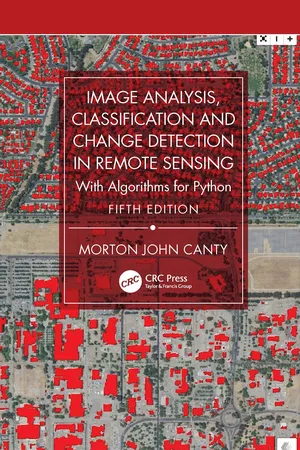
Image Analysis, Classification and Change Detection in Remote Sensing
With Algorithms for Python
- 552 pages
- English
- ePUB (mobile friendly)
- Available on iOS & Android
Image Analysis, Classification and Change Detection in Remote Sensing
With Algorithms for Python
About this book
The fifth edition of this core textbook in advanced remote sensing continues to maintain its emphasis on statistically motivated, data-driven techniques for remote sensing image analysis. The theoretical substance remains essentially the same, with new material on convolutional neural networks, transfer learning, image segmentation, random forests, and an extended implementation of sequential change detection with radar satellites. The tools which apply the algorithms to real remote sensing data are brought thoroughly up to date. As these software tools have evolved substantially with time, the fifth edition replaces the now obsolete Python 2 with Python 3 and takes advantage of the high-level packages that are based on it, such as Colab, TensorFlow/KERAS, Scikit-Learn, and the Google Earth Engine Python API.
New in the Fifth Edition:
- Thoroughly revised to include the updates needed in all chapters because of the necessary changes to the software.
- Replaces Python 2 with Python 3 tools and updates all associated subroutines, Jupyter notebooks and Python scripts.
- Presents easy, platform-independent software installation methods with Docker containers.
- Each chapter concludes with exercises complementing or extending the material in the text.
- Utilizes freely accessible imagery via the Google Earth Engine and provides many examples of cloud programming (Google Earth Engine API).
- Examines deep learning examples including TensorFlow and a sound introduction to neural networks.
This new text is essential for all upper-level undergraduate and graduate students pursuing degrees in Geography, Geology, Geophysics, Environmental Sciences and Engineering, Urban Planning, and the many subdisciplines that include advanced courses in remote sensing. It is also a great resource for researchers and scientists interested in learning techniques and technologies for collecting, analyzing, managing, processing, and visualizing geospatial datasets.
Frequently asked questions
- Essential is ideal for learners and professionals who enjoy exploring a wide range of subjects. Access the Essential Library with 800,000+ trusted titles and best-sellers across business, personal growth, and the humanities. Includes unlimited reading time and Standard Read Aloud voice.
- Complete: Perfect for advanced learners and researchers needing full, unrestricted access. Unlock 1.4M+ books across hundreds of subjects, including academic and specialized titles. The Complete Plan also includes advanced features like Premium Read Aloud and Research Assistant.
Please note we cannot support devices running on iOS 13 and Android 7 or earlier. Learn more about using the app.
Information
Table of contents
- Cover Page
- Half-Title Page
- Title Page
- Copyright Page
- Contents
- Preface to the First Edition
- Preface to the Second Edition
- Preface to the Third Edition
- Preface to the Fourth Edition
- Preface to the Fifth Edition
- Author Biography
- 1 Images, Arrays, and Matrices
- 2 Image Statistics
- 3 Transformations
- 4 Filters, Kernels, and Fields
- 5 Image Enhancement and Correction
- 6 Supervised Classification Part 1
- 7 Supervised Classification Part 2
- 8 Unsupervised Classification
- 9 Change Detection
- A Mathematical Tools
- B Neural Network Training Algorithms
- C Software
- Mathematical Notation
- References
- Index